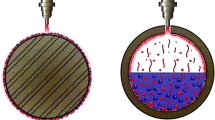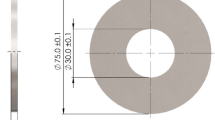Abstract
The use of cutting fluid in the grinding process is crucial to guarantee quality in the products. However, most cutting fluids can cause disease to operators and damage the environment, which adds costs to the industry, as well as a deficit in the operator’s quality of life. In addition, the metalworking industry has as problem control corrosion in their parts; it demands to add the process of remove cutting fluid of the workpieces and add a protective oil on their surface. In this context, a new class of corrosion inhibitors that use water as a propagation medium, generically known as V-active® VCI, was formulated, which made it possible to develop, firstly, a cutting fluid with the addition of such inhibitor, called generically VCI 1, which would eliminate the process of degreasing and adding protective oil. Previous research has indicated the VCI 1 has an excellent performance in the grinding process, which promoted the development of two other new fluids (named generically VCI 2 and VCI EP) at a reduced market cost to make the product more competitive. In addition to the cost savings compared with the VCI 1, the VCI EP has the differential of an extreme pressure additive. It is noteworthy that the fluids in question pose no risk to humans and are biodegradable. Thus, the performance of these two new fluids with a corrosion inhibitor was verified in the grinding process of AISI 4340 steel with an aluminum oxide grinding wheel and the results were compared with the higher market cost V-active® VCI fluid and with a base fluid without the corrosion inhibitor. The comparison took place at three different feed rates (0.25, 0.50, and 0.75 mm/min). For each feed rate, the following were evaluated: surface roughness; roundness error, diametral grinding wheel wear, microhardness, optical microscopy, and acoustic emission, and the ground surface was analyzed using scanning electron microscopy (SEM). Therefore, useful information was obtained for the technological development of the rectification process, thus adding to scientific knowledge and dissemination of knowledge to society.















Similar content being viewed by others
References
Sharma AK, Tiwari AK, Dixit AR (2016) Effects of minimum quantity lubrication (MQL) in machining processes using conventional and nanofluid based cutting fluids: a comprehensive review. J Clean Prod 127:1–18
Cameron A, Bauer R, Warkentin A (2010) An investigation of the effects of wheel-cleaning parameters in creep-feed grinding. Int J Mach Tools Manuf 50:126–130. https://doi.org/10.1016/j.ijmachtools.2009.08.008
Lopes JC, Ventura CEH, Rodriguez RL, Talon AG, Volpato RS, Sato BK, de Mello HJ, de Aguiar PR, Bianchi EC (2018) Application of minimum quantity lubrication with addition of water in the grinding of alumina. Int J Adv Manuf Technol 97:1951–1959. https://doi.org/10.1007/s00170-018-2085-8
Lopes JC, Ventura CEH, de M. Fernandes L, et al (2019) Application of a wheel cleaning system during grinding of alumina with minimum quantity lubrication. Int J Adv Manuf Technol 102:333–341. https://doi.org/10.1007/s00170-018-3174-4
de Martini FL, Lopes JC, Volpato RS et al (2018) Comparative analysis of two CBN grinding wheels performance in nodular cast iron plunge grinding. Int J Adv Manuf Technol 98:237–249. https://doi.org/10.1007/s00170-018-2133-4
Lopes JC, de Martini FL, Domingues BB et al (2019) Effect of CBN grain friability in hardened steel plunge grinding. Int J Adv Manuf Technol 103:1567–1577. https://doi.org/10.1007/s00170-019-03654-w
Pawlak Z, Klamecki BE, Rauckyte T, Shpenkov GP, Kopkowski A (2005) The tribochemical and micellar aspects of cutting fluids. Tribol Int 38:1–4. https://doi.org/10.1016/j.triboint.2004.04.004
Debnath S, Reddy MM, Yi QS (2014) Environmental friendly cutting fluids and cooling techniques in machining: A review. J Clean Prod 83:33–47
Rabiei F, Rahimi AR, Hadad MJ, Ashrafijou M (2015) Performance improvement of minimum quantity lubrication (MQL) technique in surface grinding by modeling and optimization. J Clean Prod 86:447–460. https://doi.org/10.1016/j.jclepro.2014.08.045
Sanchez JA, Pombo I, Alberdi R, Izquierdo B, Ortega N, Plaza S, Martinez-Toledano J (2010) Machining evaluation of a hybrid MQL-CO2 grinding technology. J Clean Prod 18:1840–1849. https://doi.org/10.1016/J.JCLEPRO.2010.07.002
Soković M, Mijanović K (2001) Ecological aspects of the cutting fluids and its influence on quantifiable parameters of the cutting processes. J Mater Process Technol 109:181–189. https://doi.org/10.1016/S0924-0136(00)00794-9
Chen Z, Atmadi A, Stephenson DA, Liang SY (2000) Analysis of cutting fluid aerosol generation for environmentally responsible machining. CIRP Ann - Manuf Technol 49:53–56. https://doi.org/10.1016/S0007-8506(07)62894-7
Silva VF, Batista LN, De Robertis E et al (2016) Thermal and rheological behavior of ecofriendly metal cutting fluids. J Therm Anal Calorim 123:973–980. https://doi.org/10.1007/s10973-015-4848-x
Bruni C, Forcellese A, Gabrielli F, Simoncini M (2006) Effect of the lubrication-cooling technique, insert technology and machine bed material on the workpart surface finish and tool wear in finish turning of AISI 420B. Int J Mach Tools Manuf 46:1547–1554. https://doi.org/10.1016/j.ijmachtools.2005.09.007
Oliveira DDJ, Guermandi LG, Bianchi EC et al (2012) Improving minimum quantity lubrication in CBN grinding using compressed air wheel cleaning. J Mater Process Technol 212:2559–2568. https://doi.org/10.1016/j.jmatprotec.2012.05.019
Hadad M (2015) An experimental investigation of the effects of machining parameters on environmentally friendly grinding process. J Clean Prod 108:217–231. https://doi.org/10.1016/j.jclepro.2015.05.092
Shokrani A, Dhokia V, Newman ST (2012) Environmentally conscious machining of difficult-to-machine materials with regard to cutting fluids. Int J Mach Tools Manuf 57:83–101. https://doi.org/10.1016/j.ijmachtools.2012.02.002
Ribeiro Filho SLM, Vieira JT, de Oliveira JA, Arruda ÉM, Brandão LC (2017) Comparison among different vegetable fluids used in minimum quantity lubrication systems in the tapping process of cast aluminum alloy. J Clean Prod 140:1255–1262. https://doi.org/10.1016/j.jclepro.2016.10.032
Genovez MC, Araújo LH, Pinto TD, Hrdina R (2015) New concept of corrosion protection in the presence of water: V-active VCI Concept and application. Anti-Corrosion Methods Mater 62:53–58. https://doi.org/10.1108/ACMM-06-2013-1271
Talon AG, Lopes JC, Tavares AB, Sato BK, Rodrigues AR, Genovez MC, Dinis Pinto TA, de Mello HJ, Aguiar PR, Bianchi EC (2019) Effect of hardened steel grinding using aluminum oxide wheel under application of cutting fluid with corrosion inhibitors. Int J Adv Manuf Technol 104:1437–1448. https://doi.org/10.1007/s00170-019-04005-5
Peña-Parás L, Maldonado-Cortés D, Kharissova OV, Saldívar KI, Contreras L, Arquieta P, Castaños B (2019) Novel carbon nanotori additives for lubricants with superior anti-wear and extreme pressure properties. Tribol Int 131:488–495. https://doi.org/10.1016/j.triboint.2018.10.039
Ranzani MRTC (2010) Teste De Biodegradabilidade Imediata da Substância Teste MV Aqua 100 Fluido de Usinagem. Relatório de análise: REBI.0052.0014.10.
Bianchi EC, Sato BK, Sales AR, Lopes JC, de Mello HJ, de Angelo Sanchez LE, Diniz AE, Aguiar PR (2018) Evaluating the effect of the compressed air wheel cleaning in grinding the AISI 4340 steel with CBN and MQL with water. Int J Adv Manuf Technol 95:2855–2864. https://doi.org/10.1007/s00170-017-1433-4
Javaroni RL, Lopes JC, Sato BK, Sanchez LEA, Mello HJ, Aguiar PR, Bianchi EC (2019) Minimum quantity of lubrication (MQL) as an eco-friendly alternative to the cutting fluids in advanced ceramics grinding. Int J Adv Manuf Technol 103:2809–2819. https://doi.org/10.1007/s00170-019-03697-z
Rodriguez RL, Lopes JC, Hildebrandt RA, Perez RRV, Diniz AE, de Ângelo Sanchez LE, Rodrigues AR, de Mello HJ, de Aguiar PR, Bianchi EC (2019) Evaluation of grinding process using simultaneously MQL technique and cleaning jet on grinding wheel surface. J Mater Process Technol 271:357–367. https://doi.org/10.1016/j.jmatprotec.2019.03.019
de Mello HJ, de Mello DR, Rodriguez RL, Lopes JC, da Silva RB, de Angelo Sanchez LE, Hildebrandt RA, Aguiar PR, Bianchi EC (2018) Contribution to cylindrical grinding of interrupted surfaces of hardened steel with medium grit wheel. Int J Adv Manuf Technol 95:4049–4057. https://doi.org/10.1007/s00170-017-1552-y
Bianchi EC, Rodriguez RL, Hildebrandt RA, Lopes JC, de Mello HJ, de Aguiar PR, da Silva RB, Jackson MJ (2019) Application of the auxiliary wheel cleaning jet in the plunge cylindrical grinding with minimum quantity lubrication technique under various flow rates. Proc Inst Mech Eng Part B J Eng Manuf 233:1144–1156. https://doi.org/10.1177/0954405418774599
Marinescu ID, Hitchiner M, Uhlmann E, Rowe WB (2007) Handbook of machining with grinding wheels, 1st edn. CRC Press, New York
Belentani R de M, Funes Júnior H, Canarim RC, et al (2013) Utilization of minimum quantity lubrication (MQL) with water in CBN grinding of steel. Mater Res 17:88–96. https://doi.org/10.1590/s1516-14392013005000165
de Martini FL, Lopes JC, Ribeiro FSF et al (2019) Thermal model for surface grinding application. Int J Adv Manuf Technol 104:2783–2793. https://doi.org/10.1007/s00170-019-04101-6
Marinescu ID, Rowe WB, Dimitrov B, Ohmori H (2012) Tribology of abrasive machining processes
Rowe WB Principles of modern grinding technology principles of modern grinding technology Second Edition
Arun A, Rameshkumar K, Unnikrishnan D, Sumesh A (2018) Tool condition monitoring of cylindrical grinding process using acoustic emission sensor. Mater Today Proc 5:11888–11899. https://doi.org/10.1016/J.MATPR.2018.02.162
Alexandre FA, Lopes WN, Lofrano Dotto FR, Ferreira FI, Aguiar PR, Bianchi EC, Lopes JC (2018) Tool condition monitoring of aluminum oxide grinding wheel using AE and fuzzy model. Int J Adv Manuf Technol 96:67–79. https://doi.org/10.1007/s00170-018-1582-0
Sato BK, Rodriguez RL, Talon AG, Lopes JC, Mello HJ, Aguiar PR, Bianchi EC (2019) Grinding performance of AISI D6 steel using CBN wheel vitrified and resinoid bonded. Int J Adv Manuf Technol 105:2167–2182. https://doi.org/10.1007/s00170-019-04407-5
Silva LR, Corrêa ECS, Brandão JR, de Ávila RF (2013) Environmentally friendly manufacturing: behavior analysis of minimum quantity of lubricant - MQL in grinding process. J Clean Prod 256:103287. https://doi.org/10.1016/j.jclepro.2013.01.033
Calister WD, G. DR (2014) Materials science and engineering - an introduction, 9th ed. John Wiley & Sons, Inc, Hoboken
Hadad MJ, Emami M, Sadeghi MH et al (2010) An investigation on surface grinding of AISI 4140 hardened steel using minimum quantity lubrication-MQL technique. Int J Mater Form 3:241–251
Tawakoli T, Hadad MJ, Sadeghi MH, Daneshi A, Stöckert S, Rasifard A (2009) An experimental investigation of the effects of workpiece and grinding parameters on minimum quantity lubrication-MQL grinding. Int J Mach Tools Manuf 49:924–932. https://doi.org/10.1016/j.ijmachtools.2009.06.015
Javaroni RL, Lopes JC, Garcia MV, Ribeiro FSF, de Angelo Sanchez LE, de Mello HJ, Aguiar PR, Bianchi EC (2020) Grinding hardened steel using MQL associated with cleaning system and cBN wheel. Int J Adv Manuf Technol 107:2065–2080. https://doi.org/10.1007/s00170-020-05169-1
Sabino F, Ribeiro F, Lopes JC et al (2020) Grinding assessment of workpieces with different interrupted geometries using aluminum oxide wheel with vitrified bond. Int J Adv Manuf Technol
Rodriguez RL, Lopes JC, Mancini SD, de Ângelo Sanchez LE, de Almeida Varasquim FMF, Volpato RS, de Mello HJ, de Aguiar PR, Bianchi EC (2019) Contribution for minimization the usage of cutting fluids in CFRP grinding. Int J Adv Manuf Technol 103:487–497. https://doi.org/10.1007/s00170-019-03529-0
Sato BK, Lopes JC, Diniz AE, Rodrigues AR, de Mello HJ, Sanchez LEA, Aguiar PR, Bianchi EC (2020) Toward sustainable grinding using minimum quantity lubrication technique with diluted oil and simultaneous wheel cleaning. Tribol Int 147:147
Funding
The authors thank the São Paulo Research Foundation (FAPESP) (processes 2015/09868-9, 2017/03788-9 and 2017/03789-5), Coordination for the Improvement of Higher Level Education Personnel (CAPES), and National Council for Scientific and Technological Development (CNPq) for their financial support of this research. The authors also thank the companies Norton Abrasives-Saint-Gobain Group and VCI Brasil for the donations. The authors thank all by supporting the research which is an opportunity for scientific and technological development.
Author information
Authors and Affiliations
Corresponding author
Ethics declarations
Conflict of interests
The authors declare that they have no conflict of interest.
Additional information
Publisher’s note
Springer Nature remains neutral with regard to jurisdictional claims in published maps and institutional affiliations.
Rights and permissions
About this article
Cite this article
Talon, A.G., Lopes, J.C., Sato, B.K. et al. Grinding performance of hardened steel: a study about the application of different cutting fluids with corrosion inhibitor. Int J Adv Manuf Technol 108, 2741–2754 (2020). https://doi.org/10.1007/s00170-020-05598-y
Received:
Accepted:
Published:
Issue Date:
DOI: https://doi.org/10.1007/s00170-020-05598-y




